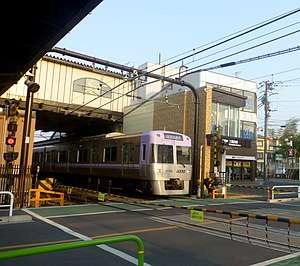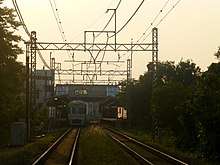Mitakadai Station
Mitakadai Station (三鷹台駅, Mitakadai-eki) is a railway station on the Keio Inokashira Line in Mitaka, Tokyo, Japan, operated by the private railway operator Keio Corporation.
Mitakadai Station 三鷹台駅 | |
|---|---|
 Mitakadai Station entrance, May 2016 | |
| Location | 1-32-1 Inogashira, Mitaka-shi, Tokyo (東京都三鷹市井の頭一丁目32番1号) Japan |
| Operated by | |
| Line(s) | |
| Platforms | 2 side platforms |
| Connections |
|
| Other information | |
| Station code | IN15 |
| History | |
| Opened | 1933 |
| Traffic | |
| Passengers (FY2014) | 22,597 daily |
Lines
Mitakadai Station is served by the 12.7 km Keio Inokashira Line from Shibuya in Tokyo to Kichijōji. Located between Kugayama and Inokashira-kōen, it is 11.2 km from the Shibuya terminus.[1]
Service pattern
Only all-stations "Local" services stop at this station. During the daytime, there are eight services per hour in either direction.
Station layout

The station consists of two ground-level side platforms serving two tracks.[2] The station building is built above the tracks.
There are elevators from the concourse to each of the two platforms, and to the north exit of the station. The stairway from the north exit is connected by a pedestrian bridge over the road below, which the rails also cross.
There are toilets accessible from platform one, with a "multi-purpose" toilet as well as men's and women's toilets.
Platforms
| 1 | ■ Keio Inokashira Line | for Kichijōji |
| 2 | ■ Keio Inokashira Line | for Shimo-Kitazawa, Meidaimae, and Shibuya |
Adjacent stations
| « | Service | » | ||
|---|---|---|---|---|
| Keio Inokashira Line (IN15) | ||||
| Express: Does not stop at this station | ||||
| Kugayama (IN14) | Local | Inokashira-kōen (IN16) | ||
History
The station opened on 1 August 1933.[1]
From 22 February 2013, station numbering was introduced on Keio lines, with Mitakadai Station becoming "IN15".[3]
Passenger statistics
In fiscal 2014, the station was used by an average of 22,597 passengers daily.[4]
The passenger figures for previous years are as shown below.
| Fiscal year | Daily average |
|---|---|
| 1999 | 21,080[1] |
| 2010 | 22,832[5] |
| 2011 | 22,574[5] |
Surrounding area
- Kanda River
- St. Margaret's Junior College
- St.Margaret's Junior & Senior High School
References
- Terada, Hirokazu (July 2002). データブック日本の私鉄 [Databook: Japan's Private Railways]. Japan: Neko Publishing. p. 206. ISBN 4-87366-874-3.
- Kawashima, Ryozo (April 2010). 日本の鉄道 中部ライン 全線・全駅・全配線 第1巻 東京駅―三鷹エリア [Railways of Japan - Chubu Line - Lines/Stations/Track plans - Vol 1 Tokyo Station - Mitaka Area]. Japan: Kodansha. pp. 12, 55. ISBN 978-4-06-270061-0.
- 京王線・井の頭線全駅で「駅ナンバリング」を導入します。 [Station numbering to be introduced on Keio Line and Inokashira Line] (PDF). News release (in Japanese). Keio Corporation. 18 January 2013. Retrieved 25 March 2013.
- 1日の駅別乗降人員 [Average daily station usage figures] (in Japanese). Japan: Keio Corporation. 2014. Retrieved 25 March 2016.
- 1日の駅別乗降人員 [Average daily station usage figures] (in Japanese). Japan: Keio Corporation. 2013. Retrieved 25 March 2013.
External links
| Wikimedia Commons has media related to Mitakadai Station. |
- Mitakadai Station information (Keio) (in Japanese)